On Nov 30, 2011, we strode into City Hall for our second public hearing -- one year, almost to the day, from when we first submited our application on Dec 2, 2010.
The following is our slide and spoken presentation at that hearing. I delivered this barrage of facts and analysis in a fifteen-minute tour de force of laser-pointer-assisted persuasion.
The text is almost exactly as I read it that evening. My first draft took twice the allotted time; Anne -- who prepared all the slides -- gave ruthless direction about what to cut. Through many practice readings (often sotto voce as I rode the bus to work), I found that my normal writing style is not easy for me to read aloud. I revised each sentence several times, not just for impact but also to make everything easier to say and hear, sometimes at the cost of grammatical integrity. (Horrors!)
I've left my stage directions below, in brackets. ALL CAPS reminds to me to speak with emphasis, and slowly. I tend to rush and get tongue-tied when I'm nervous or excited, and I was plenty nervous at this hearing. I thought that two commissioners would be for us and two against, with a 50-50 chance for the swing vote. My expectation was for an indefinite continuance, without clear direction on the key objections to our project, and thus with no end in sight to our financial quagmire.
It was with all that in mind that I got up to speak that night. Here's what I said and showed:
=========================================
INTRODUCTION
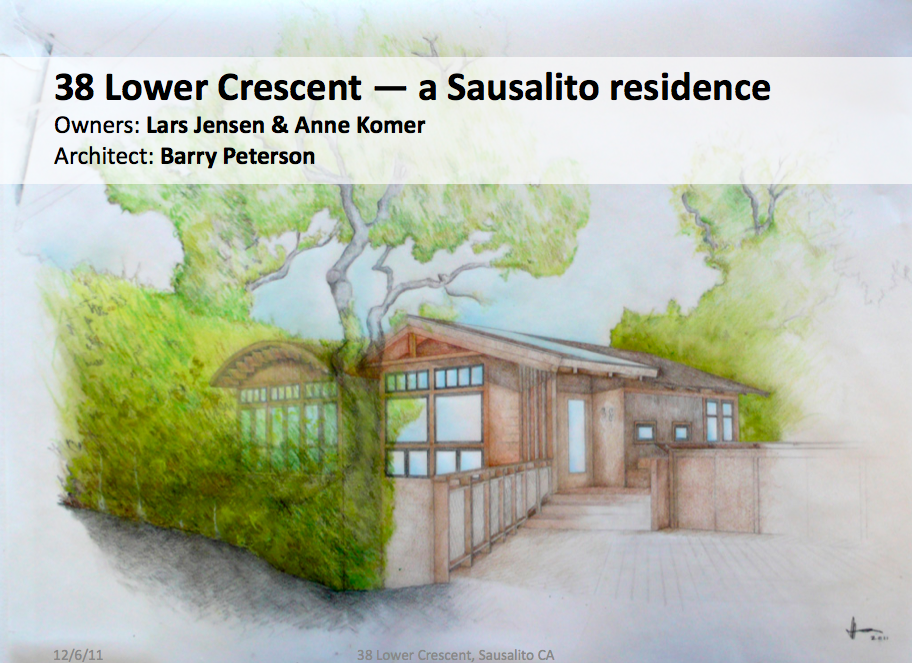
Good evening. I'm Lars Jensen. My wife is Anne Komer, and we've enjoyed living in Old Town for 6 years.
At 38 Lower Crescent, we want to build a modest house with a BAY VIEW. One with a little style, but in harmony with its surroundings.
Since our first hearing, we've made some big changes to squarely address the critical issues that we heard.
In fact, after that hearing ended in denial, we decided to get an independent perspective. The next day, we consulted with architect Don Olsen, who was at that hearing. He said he thought we should do 3 things:
- lower the roof
- eliminate the second unit
- eliminate the driveway

So we did all those things. The building is lower by three feet. It's now just a few inches higher than the existing building. The second unit and driveway are gone. We also moved the spiral stair from front to back, and replaced the steel entry deck with this parking deck on the right. Shipping containers are no longer in view.
I hope you've all seen the slides that we included in your packets. I'll go a little deeper into some of those points.
=========================================
OAK LANE
First, I want to talk about the impact on Oak Lane.
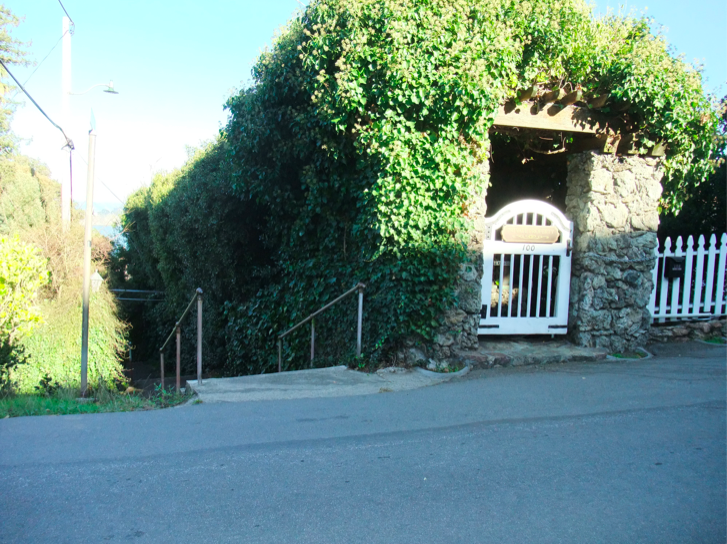
Sausalito [pause] is not the countryside. It is a dense village. The public steps aren't meant to be wide-open viewing parks. They're clever pedestrian shortcuts over sewer easements.
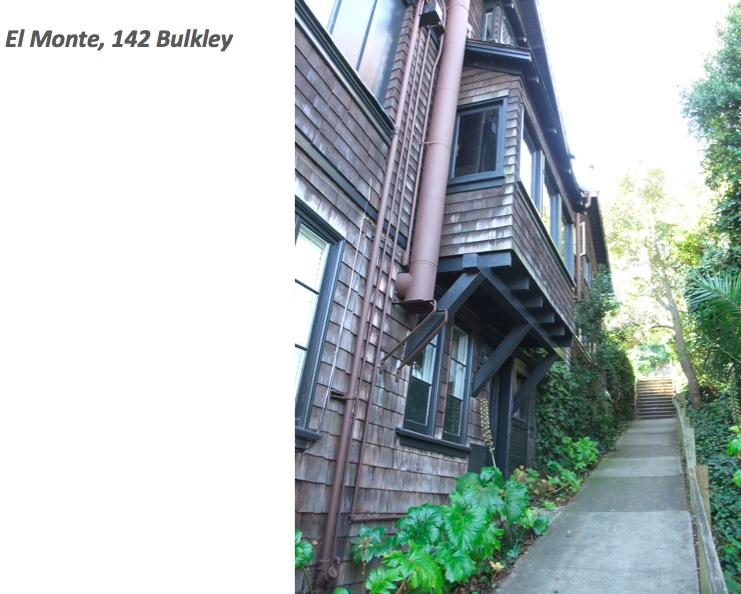
They're often close to buildings because they run where 5-foot setbacks are the norm. That closeness gives them a romance and charm that some people call "European".
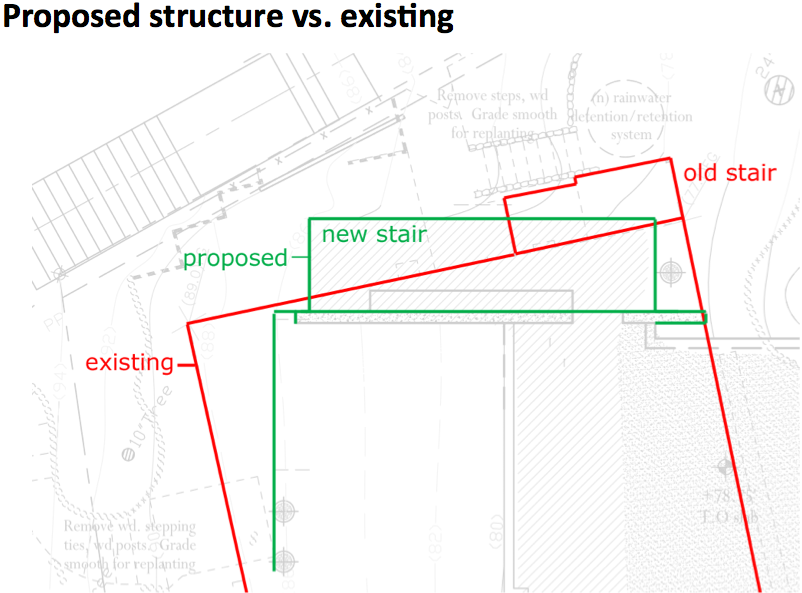
Zoning Ordinance 10.40.080 reflects this. It specifies MORE LENIENT setbacks next to narrow lanes. It lets us take our side setback from the CENTER of Oak Lane, not from the property line.
By the way, the Staff report states incorrectly that we are at the 5-foot setback line here [laser]. We're actually at 8.5 feet -- the setback, plus 3 1/2 feet. And it's even further to the main mass of the building.
Also, observe that the shipping containers alongside Oak Lane are gone. Two containers were stacked right here [laser], in the new stair location.
Note that we rotate the new building away from Oak Lane. The main mass of the new building [laser] is actually FURTHER from Oak Lane than the old one. The new side stair is a little closer than the old corner, but it follows the grade DOWN. Pedestrians will look DOWN at this new stair, not up at the old stair as they do today. Minimal impact.
Another note on the rotation: Zoning Ordinance 10.40.090 (part D) actually lets diagonal sidewalls project INTO side setbacks. We're not asking for this -- but it just reinforces the MINIMAL impact of our diagonal siting.
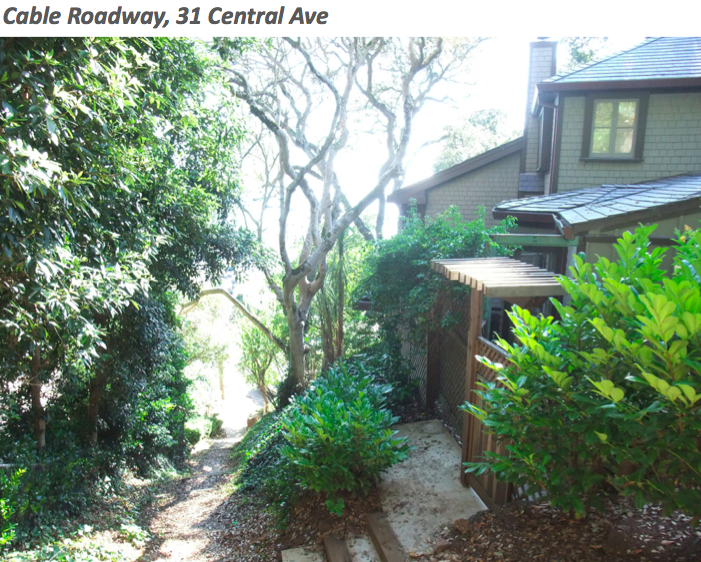
There's a good stand-in for this project at 31 Central Ave. Like us, it's a two-and-a-half story house, on the south side of its lane, with a diagonal footprint, at a comparable distance. The light and air here is more than "adequate".
The Staff Report seems to use that phrase "impact on light and air" as a general proxy for building presence, or massing, or height. But the findings actually call for "ADEQUATE light and air". Not "maximum", not "plentiful", not "zero impact". "ADEQUATE LIGHT AND AIR".
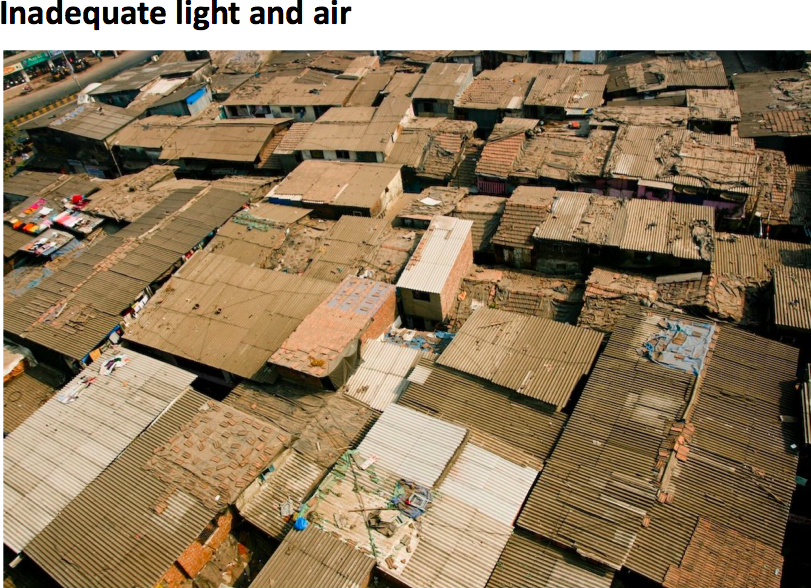
This is inadequate light and air. That phrase is historically about the LITERAL blocking of sunlight and air circulation, leading to concerns of public health and basic livability.
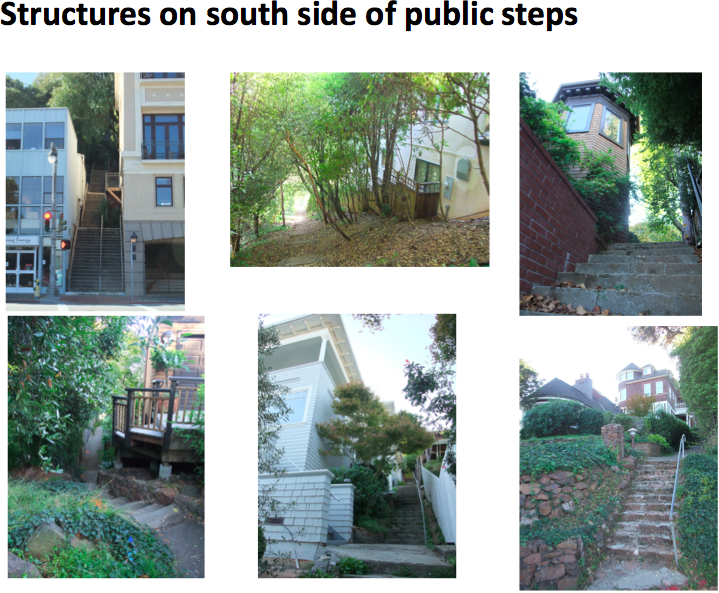
Here are just a few examples that are closer and taller than our building. Even though these are all on the south side of their lanes, there is PLENTY of light and air here.
At our last hearing, Dorothy Gibson's name was invoked to talk about the "special nature" of Oak Lane. So we invited Dorothy to the site. I went through the plans and story poles with her. She clarified that what she thought was special about Oak Lane was the oaks themselves, their place in Sausalito history, and the enclosure and shade that they provide. I asked her point blank whether she thought this proposal would had a negative impact on Oak Lane. I did this with some trepidation, since Dorothy is known for saying what's on her mind, no matter who's asking.
Her response was "I don't think it's a big deal."
Dorothy is here tonight, and can speak to this if you like.
In the end, we are just expanding an attic into a full story. Our impact on Oak Lane is very small.
=========================================
NEIGHBORHOOD COMPATIBILITY
Next, I'd like to address neighborhood compatibility.
First off, what IS our neighborhood? Is it the street? Or the hill? Well, the "Land Use & Growth Management Element" (p. 2-30) has a "Description of Sausalito's Eight Neighborhoods", and it lists the NEIGHBORHOOD for this project as "Old Town".

As we all know, Old Town is very eclectic. People seem to like that.
[pause]
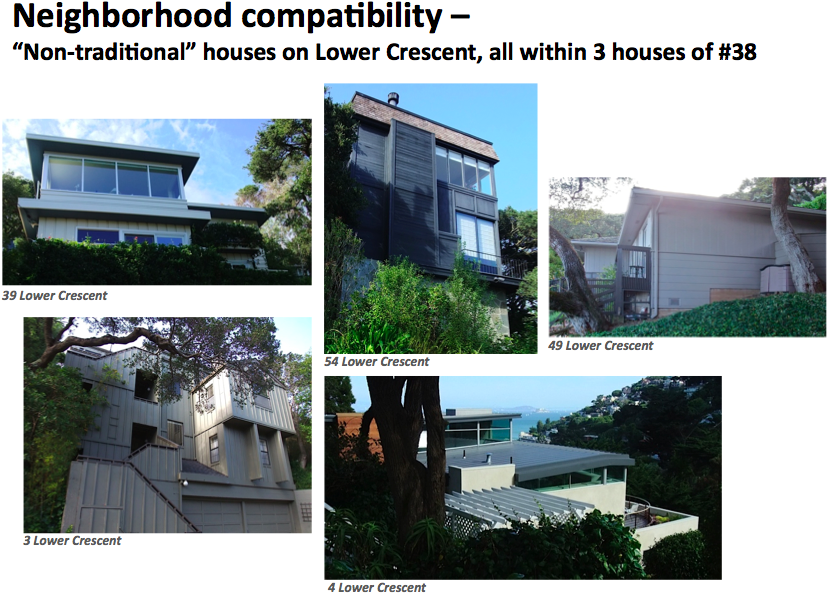
Even on Lower Crescent itself, we see plenty of nontraditional architecture.
[pause]
Most importantly, our immediate neighbors don't have compatibility issues with our proposal. Some even said that they "love it".
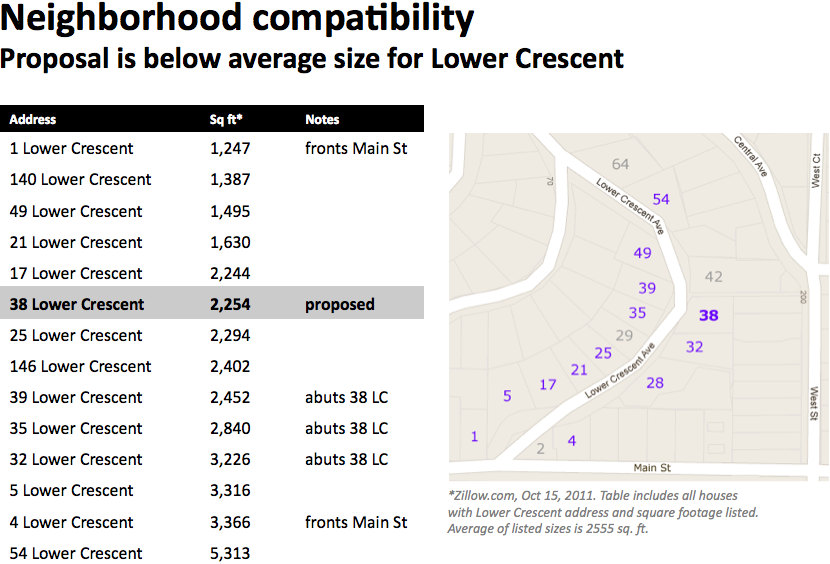
The house was called "too big". Yet it has less square footage than the average Lower Crescent house, and less than ANY neighboring house.
What about those shipping containers? Well, the two that remain are tucked under the house, between foundation walls. The Staff Report (p.5) says that they "will be visible from...Oak Lane and from the downslope properties to the east".

But actually, downslope neighbors would see only the window ends of those containers, heavily screened by shrubs and trees. And you would ONLY see them from Oak Lane if you look through the fence slats. This broken one shows the container level.

Regarding materials: the PREDOMINANT material on the house is clear-stained cedar, just like this house at 405 Main St, in Old Town. This was designed by our architect.
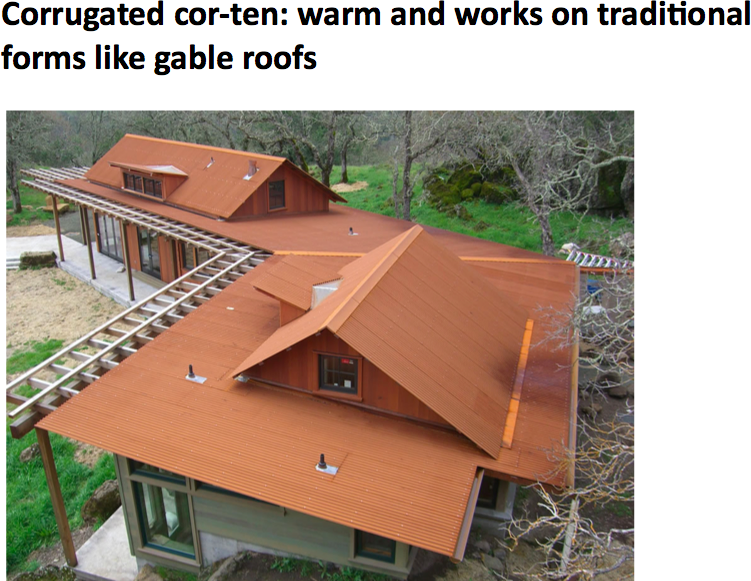
And here's a good example of the oxidized cor-ten steel on a gable roof, as we propose.
These materials are warm, muted earth tones. They help the house nestle into its wooded site, just as the existing building does.
The Staff Report (p.5) also mentions a "...slight industrial and modern feel...". Well, even if we agreed with the "industrial" part, we don't see how a "slight" feel rises to the level of "incompatibility". If Commissioners still feel that this project is too "industrial", we really need to hear about that in some specific detail. Otherwise we're just guessing at what is being objected to.
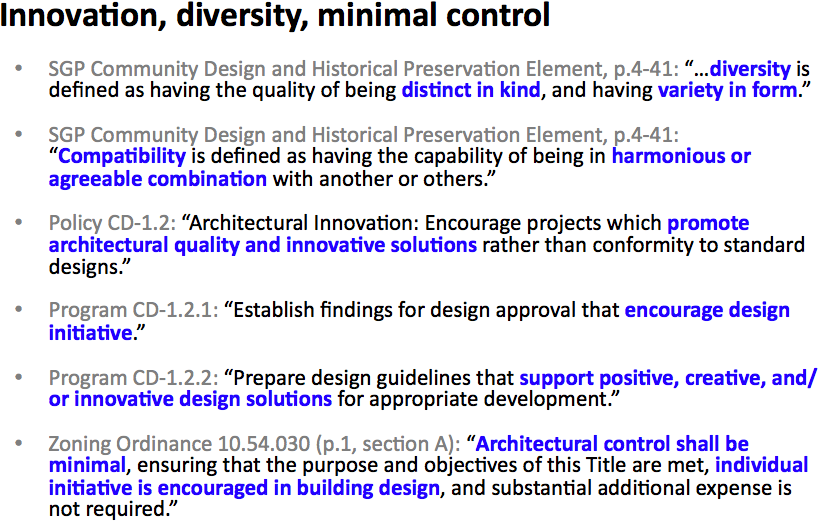
We took inspiration from the Community Design & Historical Preservation Element (p.4-2). This says that Sausalito wants to
- "promote...innovative solutions"
- "encourage design initiative", and
- exert "minimal architectural control"
...among other things.
We feel STRONGLY that this proposal rises to these policies, and that neighborhood COMPATIBILITY is assured.
=========================================
PUBLIC VIEW
Next, I'd like to address the public view issue.
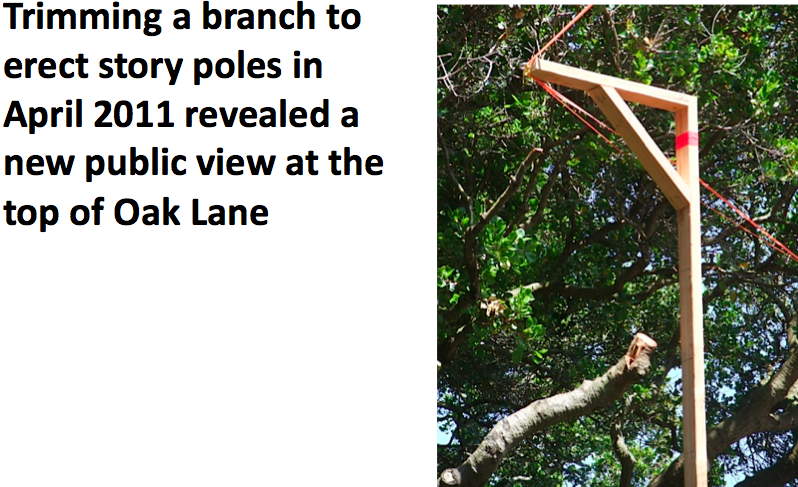
As a reminder, this concerns a new view of San Francisco from the landing at the top of Oak Lane, which was created in April of this year, when a worker on the roof trimmed a branch that was in conflict with a story pole.
Some people say we're obliged to maintain this view, despite when and how it was created.
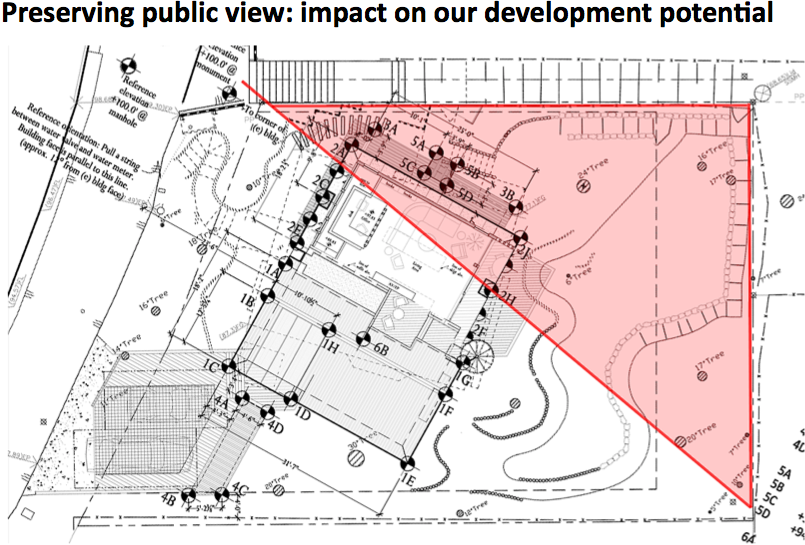
The red area [laser] shows the impact on our living room and main deck if that were the case. Obviously, this would be devastating for the proposed design. You don't just take out half the living room and build the rest of the house as is.
The Staff Report suggests moving the house down the hill, to the east. Unfortunately, this would make things worse, for just about everyone. It would mean:
- costlier downhill construction, and
- more objection from neighbors, including downhill abutters, who are happy so far
- It would eliminate our own view, with SEVERE reduction of our property value
- It would mean more site disturbance, with removal of more protected trees
To get a fresh perspective on this, we hired architect Michael Rex as a consultant. I spent four hours with him at the site. In his opinion, responding to this new constraint would have ripple effects all through the building, right down to the foundation. It would mean redesigning the entire house. From scratch.
To say the least, we question whether this is an optimal tradeoff for the town to make.
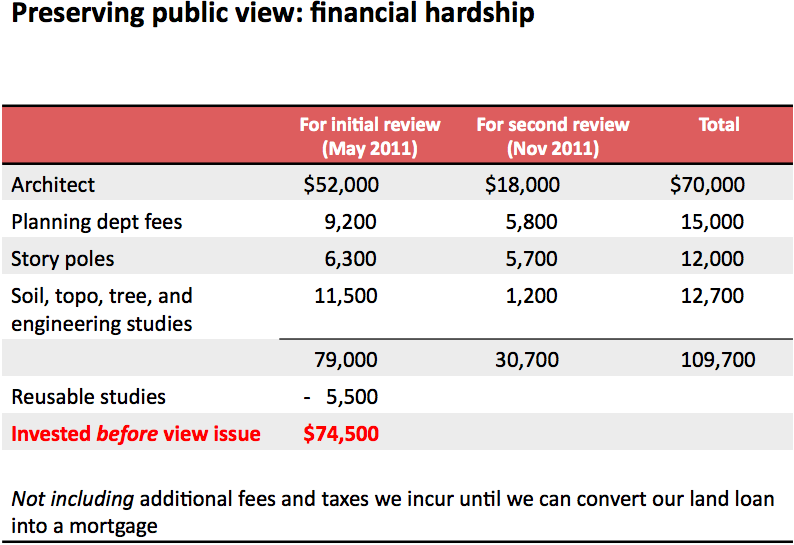
Starting over, losing a year of design and permitting effort, would forfeit $70,000 worth of work. This is what it cost to get to our first hearing in May, when this issue was first raised. This DOES NOT count re-usable work. And it DOES NOT count TENS OF THOUSANDS in finance costs for that same period. To us, these costs ARE a VERY substantial hardship.
ALL THIS because we accidentally trimmed a branch in April.
We made this major design investment, in GOOD FAITH. We worked with neighbors for a YEAR to find a design everyone can live with. The town had our application IN HAND for FIVE MONTHS, and never mentioned this hidden view as something to watch out for. The regulations NEVER MENTION that views behind branches have to be preserved.
It doesn't make sense to hold us to a condition that WASN'T THERE during ALL OF this, just because of an inadvertent by-product of the permitting process.
It wouldn't make sense if the branch had fallen in the wind, or if part of our crumbling house had collapsed and exposed a view.
We also note the Community Design and Historical Preservation Element (p.4-5) -- Policy CD 3.1 states about Private Views that..."some minor loss of view may be consistent with this policy if necessary to protect a property right."
It seems reasonable to extend this principle to public views.
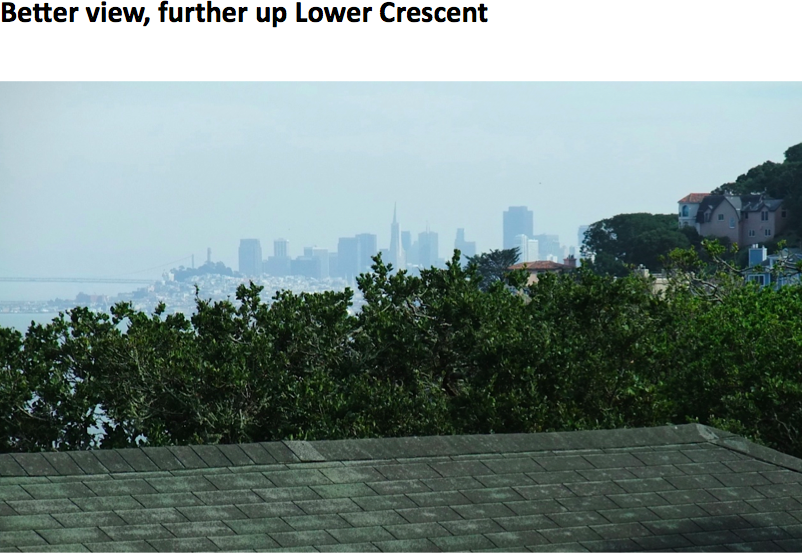
Even on Lower Crescent, this view is hardly unique. Here's another example of it. As you walk down the street, the view comes and goes. Some trees hide it, others reveal it. Making US maintain a PARTICULAR new version of it, in the face of such drastic consequences for us as property owners, seems very out of balance.
If the regulation had been applied in the past as is being suggested now, most of the houses on the downhill side of streets wouldn't be there at all.
=========================================
PARKING DECK
I want to go into one more issue, which is our parking deck.
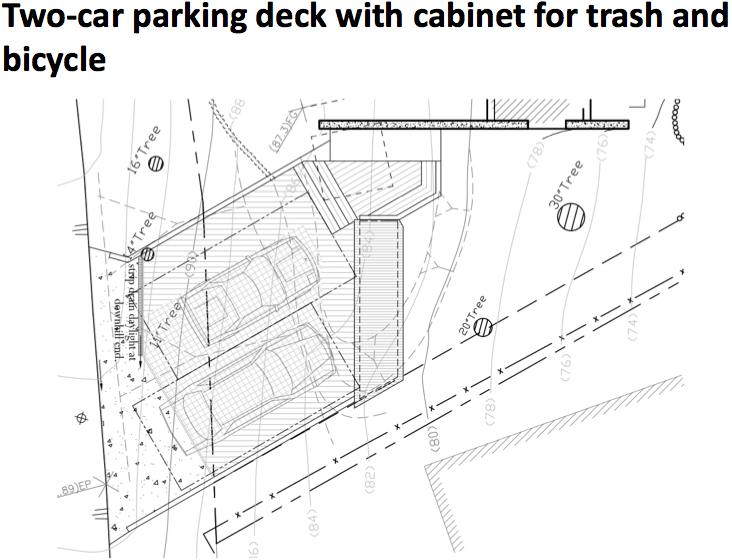
We understand our neighbor's initial reaction to a new deck near his property. Story poles are always off-putting. But we feel that the Staff Report greatly overstates this deck's impact. Particularly by more use of this phrase "light and air".
For instance, it says that the deck "eliminates THE light and air from the residence" next door. This makes it sound like our neighbor will be gasping in the dark. But in fact there will be NO air impact, and very little light impact, if any at all.
This deck edge [laser] runs due east and west, on the NORTH side of this neighbor's yard. [pause] It's not going to cast shadows on his property. The sun just doesn't go there.
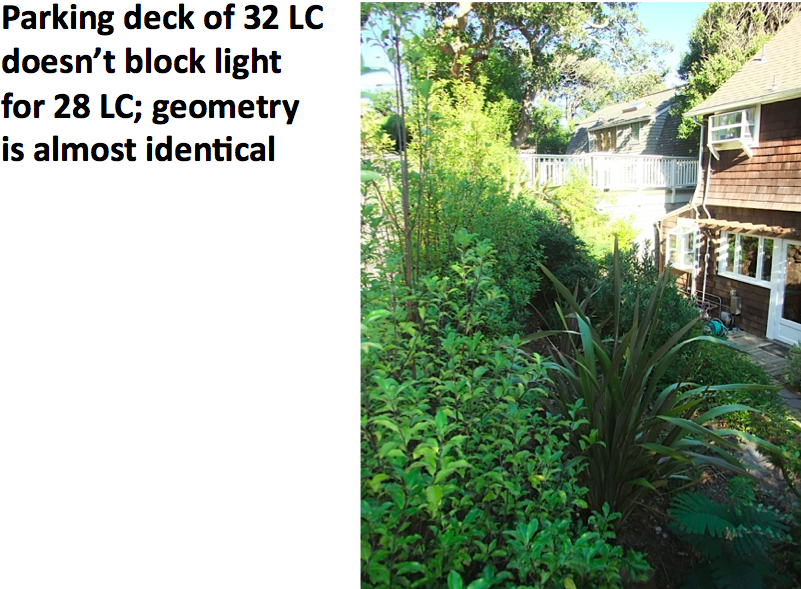
THIS HAPPENS to be the house of SCOTT'S downhill neighbor. It's a very similar arrangement, except that our deck doesn't run past the sidewall of Scott's house, like this one does. [pause] You can see that the wall under this parking deck actually REFLECTS a lot of light into that yard. It's a SOURCE of sunlight for that corner room.
Scott's yard is sunny like this. It will be just as sunny after this deck is built.
The Staff Report describes the deck as "blocking light from entering the residence through windows and double glass doors on front and side". It's possible that at times, there MIGHT be some SMALL reduction in OVERALL light levels in that corner room. But this talk about "blocking" and "eliminating" just doesn't match the actual situation. The deck is not between Scott's house and any light source, including the sky. The trees around here block far more light than the deck ever could.
This deck won't hover over Scott's house like a UFO. It's five feet from the property line, OUTSIDE of our setback area. AND, we intentionally kept it from going past Scott's side windows.
I should note that Scott's house projects into his own side setback area, and the fence is a foot or so on our side of the property line, making the deck seem closer to Scott's property than it is. These are NOT ISSUES for us -- but we shouldn't be penalized for them either.
Now, Scott has asked us to remove this storage cabinet. We can see his point. We need some outside storage, but we can get by with less.
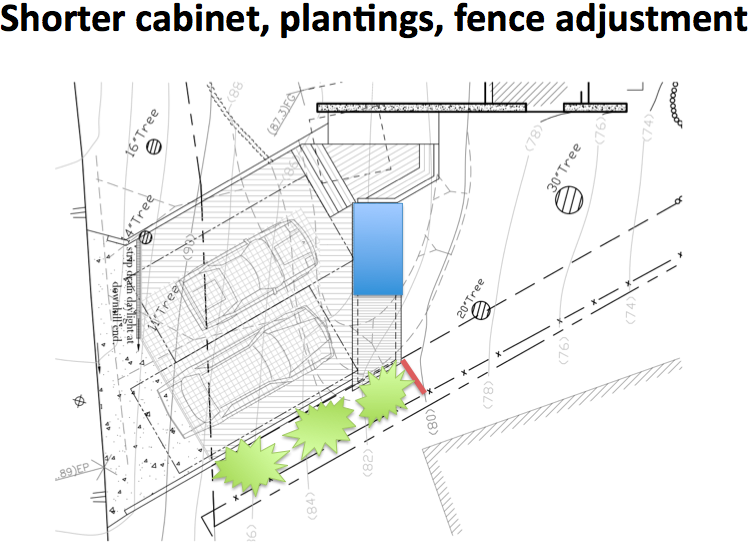
- We've offered plantings in the setback area, subject to Scott's approval.
- We've also offered to hold the end of the cabinet another 5 feet away from the setback.
- We could jog this fence [laser] to meet the deck, making Scott's yard seem larger.
- We also offered to move the deck by around a foot (though that makes it higher and probably wouldn't make much difference in the end).
So far, Scott hasn't taken us up on all of these. But they're still on the table.
[pause] In the end, this is an underdeveloped, uphill property. You've got to assume that someday, someone's going to bring it up to the norm. Until then, you get to BENEFIT from its underdeveloped state. But that's not a permanent entitlement.
Commissioner Bair recently said that "Everyone loves underdeveloped property, except the people who live there." Sure -- it's like having a park next door.
[slow] But of course, it's not a park. It's our property. We need two parking spaces. We've minimized the impact of this footprint as much as we can for Scott.
=========================================
CONCLUSION
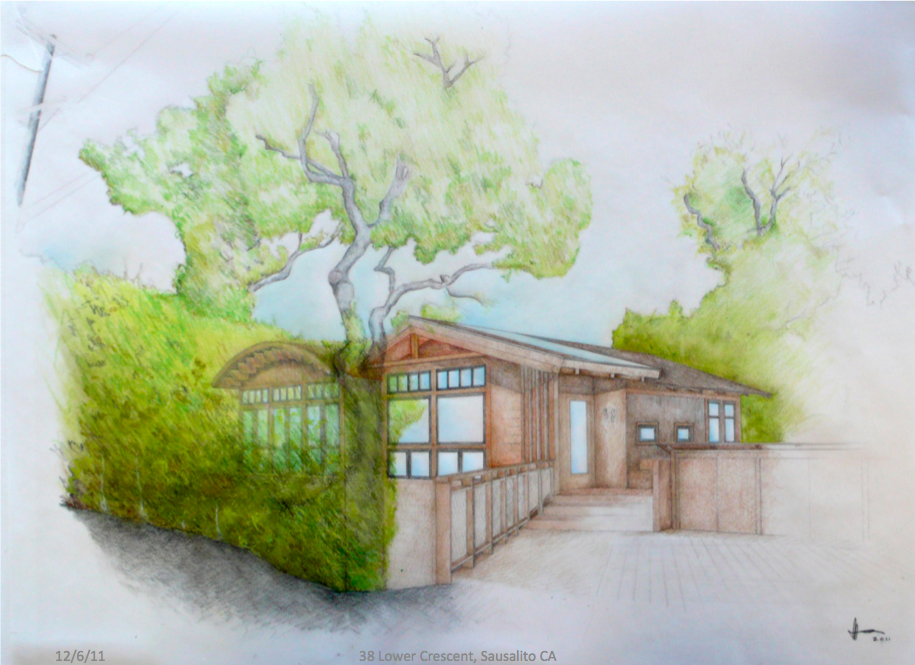
To wrap up: our proposal is a MODEST, WELL-DESIGNED house that is INNOVATIVE in its approach to addressing neighbor concerns. It is WELL WITHIN ALL development standards. It sits at a RESPECTFUL distance from its neighbors.
It doesn't ask for ANYTHING that other houses on the hill don't have. We are VERY confident that it will be seen as a positive contribution to the design diversity of Sausalito, JUST LIKE our architect's previous work in town.
We wouldn't want a house that was anything else.
=========================================
=========================================
Although my practice rounds consistenly clocked in at fourteen minutes, I ended up taking a little over fifteen on the night, even skipping a couple of paragraphs at the end. Once I got started, I got over my nerves and tried to speak with full commitment and authority. Everyone laughed at the Mumbai slide, which made me feel that the room was with me as I went into the more difficult topics of the public view and the parking deck. On these issues, I knew that some people in the room were against us.
Most neighbors spoke in support. But not everyone was on our side. As expected, one resident said we shouldn't be allowed to block the public view. And the neighbor closest to our parking deck objected to its height and proximity.
But having learned from our first hearing, we didn't hesitate to stand up and rebut things that we thought needed clarification, even though our official time to speak was over. The commissioners don't seem to mind this as long as you make your point concisely. Local author and prominent citizen Dorothy Gibson spoke in our favor. Consulting architect Michael Rex firmly backed up my claims about the building envelope and view lines when commissioners seemed skeptical about them.
Then it was time for the commissioners to discuss among themselves. One by one, they warmly complimented this project about which they had virtually nothing positive to say last time. They uniformly rejected the objections. We were stunned as our biggest detractor in the first hearing became our biggest supporter in this one, making points for us as if we had scripted them ourselves. Commissioner Stan Bair was clearly pleased to have been quoted.
In the end, all five commissioners voted to approve, subject to some minor parking deck modifications to be approved at the next meeting. In the hallway immediately afterward, we met with the neighbor on that side and worked out those changes, and he subsequently (and graciously) wrote a letter to the town in full support of the project.
Two weeks later, the formal vote of approval took place.
Ten days later, on Christmas Eve, the appeal period expired, and our permit went into effect. It's good through Dec 24, 2016, with the possibility of a one-year extension.
The hard part is done. Now we just have to find the money and build the house. At last, our future is in our own hands again.
Hallelujah!
|